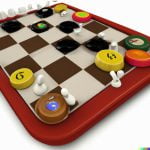Are you ready to dominate the energy market and emerge victorious in the Power Grid board game? In this comprehensive strategy guide, we’ll delve into the intricacies of the game and provide valuable tips for mastering its mechanics and emerging triumphant. Whether you’re a newcomer to the game or a seasoned player looking to elevate your skills, this guide will equip you with everything you need to know to develop a winning strategy.
Power Grid is a strategic board game that challenges players to build and expand their power networks while effectively managing resources and navigating auction mechanics. As you strive to outmaneuver your opponents and achieve dominance in the energy sector, our guide will provide valuable insights into maximizing your efficiency and securing victory.
From understanding the rules and mechanics of Power Grid to analyzing different power plants and developing a winning bidding strategy, this article will cover every aspect of gameplay. Let’s dive into the world of Power Grid and equip ourselves with the knowledge needed to excel in this thrilling game.
Understanding the Power Grid Board Game Rules and Mechanics
The Power Grid board game is a strategic tabletop game that puts players in the shoes of energy entrepreneurs, vying to power the most cities and earn the most money. To excel at this game, players must not only understand the rules but also master the mechanics that drive the gameplay.
The Basics of Power Grid Rules
In Power Grid, players compete to supply electricity to the most cities on the game board. The core gameplay revolves around buying power plants, purchasing resources to power those plants, and expanding their network of cities. The game is played over several rounds, with each round consisting of several phases: auctioning power plants, buying resources, expanding networks, and powering cities.
Understanding Key Mechanics
One crucial mechanic in Power Grid is the market for power plants and resources. Players must carefully manage their budget to buy efficient power plants while also securing enough resources to fuel them. Additionally, as the game progresses, players must contend with fluctuating resource prices and competition for prime locations on the game board.
Strategic Considerations
To excel at Power Grid, players need to balance immediate needs with long-term efficiency. Understanding how different elements of the game interact – such as choosing optimal power plants for their resource costs or expanding into new cities without spreading too thin – is essential for success in this competitive board game.
By mastering these rules and mechanics, players can lay a strong foundation for developing winning strategies in Power Grid.
Analyzing Different Power Plants and Their Benefits
When playing the Power Grid board game, understanding the different types of power plants and their benefits is crucial for developing a winning strategy. Each power plant comes with its own set of advantages and drawbacks, and knowing how to utilize them effectively can give players a competitive edge. Here are some key points to consider when analyzing different power plants in the game:
- Fuel type: One of the main factors to consider when evaluating power plants is the type of fuel they require. Some power plants are more efficient with certain types of fuel, so it’s important to weigh the availability and cost of fuel when choosing which plants to acquire.
- Power output: Different power plants have varying levels of power output, with some producing more electricity than others. Consider the size of your growing network and your overall energy needs when deciding which power plants to purchase and use.
- Efficiency and cost: Some power plants may be more expensive to purchase initially but offer greater efficiency or lower operating costs in the long run. Understanding the cost-benefit ratio of each plant is essential for optimizing your resources.
By carefully analyzing these factors, players can make informed decisions about which power plants to acquire and how to strategically use them throughout the game. A well-rounded understanding of different power plants and their benefits can set the foundation for a successful Power Grid board game strategy.
Ultimately, mastering the intricacies of each type of power plant allows players to adapt their strategies based on the ever-changing market conditions and their opponents’ actions. Incorporating a diverse range of plant types into your network can provide flexibility and resilience, enabling you to navigate obstacles and emerge victorious in this challenging game that requires both tactical planning and adaptability.
Tips for Efficient Resource Management and Acquisition
In the Power Grid board game, efficient resource management and acquisition are crucial for success. Without a steady supply of resources, your power plants will struggle to generate electricity, hindering your ability to expand your network and secure victory. Here are some tips to help you effectively manage and acquire resources in the game:
- Plan Ahead: It’s important to anticipate your resource needs several turns in advance. Keep track of how much each city on the map consumes, and plan your resource purchases accordingly. This will prevent you from running out of essential resources when you need them most.
- Diversify Your Resource Portfolio: In Power Grid, different types of power plants require different resources to operate. It’s beneficial to diversify your portfolio by investing in a variety of resources, rather than relying solely on one type. This will give you flexibility and enable you to adapt to changing market conditions.
- Monitor the Resource Market: The cost of resources fluctuates throughout the game, so it’s important to monitor the resource market closely. Look for opportunities to purchase resources at low prices, and avoid overpaying for them if possible. Pay attention to other players’ resource needs as well, as this can affect market dynamics.
Effective resource management and acquisition are essential components of a winning strategy in Power Grid. By planning ahead, diversifying your resource portfolio, and keeping a close eye on the resource market, you can ensure that your power plants remain operational and competitive in the game.
By following these tips, players can greatly improve their chances of success in the Power Grid board game while enhancing their overall gaming experience with a deeper understanding of strategic gameplay.
Developing a Winning Bidding Strategy
When it comes to the Power Grid board game, developing a winning bidding strategy is crucial for success. The auction phase of the game is where players compete to acquire power plants and resources, which will ultimately determine their ability to expand their power grid network and secure victory. Here are some key tips for developing a successful bidding strategy in Power Grid.
Understanding the Value of Power Plants
One important aspect of developing a winning bidding strategy is understanding the value of different power plants. Consider not only the immediate cost of acquiring a power plant, but also its potential long-term benefits. Look for power plants that offer a good balance of efficiency, resource requirements, and capacity in order to maximize your energy production while minimizing costs.
Assessing Your Opponents’ Strategies
In the auction phase of Power Grid, it’s important to pay attention to your opponents’ strategies and adapt accordingly. Take note of their current power plant capacities, available resources, and overall gameplay style. This will help you make informed decisions when it comes to bidding on power plants and resources, allowing you to capitalize on opportunities and adjust your strategy as needed.
Bidding Wisely
Bidding wisely is another key component of developing a winning strategy in Power Grid. Avoid overbidding on power plants that may not provide significant long-term benefits or require excessive resources to operate efficiently. Conversely, don’t be afraid to strategically increase your bid when necessary in order to outmaneuver opponents and secure valuable power plants that align with your overall game plan.
By understanding the value of power plants, assessing your opponents’ strategies, and bidding wisely, you can develop a winning bidding strategy that sets you up for success in the Power Grid board game. Keep these tips in mind as you navigate the auction phase and work towards building an efficient and effective power grid network.
How to Expand Your Power Grid Network Effectively
Expanding your power grid network is a crucial aspect of the Power Grid board game, as it allows you to reach more cities and generate more income. One key strategy for effective expansion is to focus on connecting cities with high value and potential for growth. By targeting these cities, you can maximize the return on your investment in building new connections and expand your network efficiently.
Another important factor to consider when expanding your power grid network is timing. It’s essential to strike a balance between expanding too quickly and overextending yourself, or waiting too long and falling behind your opponents. Assessing the map and evaluating the current state of the game can help you determine the optimal time to expand, taking into account both immediate gains and long-term benefits.
Furthermore, diversifying your power sources is crucial for an effective network expansion in Power Grid. This means investing in different types of power plants to supply energy to different regions of your expanding network. By having a diverse range of power sources, you can ensure stability in your energy production and minimize the impact of fluctuations in resource prices or availability.
| Aspect | Consideration |
|---|---|
| Cities Targeted | Focus on connecting high-value cities with potential for growth |
| Timing | Strike a balance between expanding too quickly or waiting too long |
| Diversifying Power Sources | Invest in different types of power plants for stability in energy production |
Utilizing Power Grid Board Game Expansion Packs for a Competitive Edge
Expanding your strategy options in the Power Grid Board Game can be a game-changer, especially when you incorporate expansion packs into your gameplay. These add-ons introduce new elements and mechanics that can give you a competitive edge against your opponents. Whether it’s new power plants, different resources, or additional map boards, these expansions can provide fresh challenges and opportunities for skilled players.
One popular expansion pack is the “Power Grid: The New Power Plant Cards” which introduces alternative resource-powered plants, making the game even more versatile and complex. Another favorite among players is the “Power Grid: Brazil/Spain & Portugal” map pack, which offers unique geographical layouts, resource availability, and rule variations that add depth to the gameplay. By exploring these expansion packs, you can diversify your strategies and adapt to different scenarios, keeping your opponents on their toes.
Incorporating expansion packs into your Power Grid gameplay requires careful consideration of how these additions will impact your overall strategy. You may need to adjust your resource management tactics or bidding approach to make the most of the new features introduced by these expansions. With a thorough understanding of how the expansion packs alter the dynamics of the game, you can leverage them to gain a competitive advantage and secure victory in this intense board game of strategic decision-making.
Mastering Endgame Tactics and Securing Victory
In the Power Grid board game, the endgame is where everything comes together and players must make strategic decisions to secure victory. This phase of the game requires a different approach compared to the early and mid-game stages. To ensure success in the endgame, players need to master specific tactics that will give them an edge over their opponents.
One crucial aspect of mastering endgame tactics is understanding when to push for expansion and when to focus on consolidation. Players should assess their current position on the game board and determine if they have enough resources and power plants to sustain further expansion. It’s essential to strike a balance between growing your network and ensuring that it remains efficient as you near the end of the game.
Another key factor in securing victory in the Power Grid board game’s endgame is monitoring your opponents’ progress closely. By keeping an eye on their actions and resources, you can anticipate their next moves and adjust your strategy accordingly. Additionally, being aware of their potential power plant purchases and network expansion plans allows you to make informed decisions that could give you a competitive advantage.
Additionally, players should pay close attention to the available power plants during the endgame. As resources become scarcer, it’s crucial to adapt your strategy based on the types of power plants that are up for auction or purchase.
This may require making tough decisions about continuing with outdated power plants or making a substantial investment in more efficient ones. By carefully managing your power plant portfolio in the endgame, you can maximize your chances of securing victory in the Power Grid board game.
Overall, mastering endgame tactics is essential for securing victory in the Power Grid board game. By carefully balancing expansion and consolidation, monitoring opponents’ progress, and adapting power plant purchases according to resource availability, players can increase their chances of achieving success in this strategic board game.
Conclusion and Recap of Key Power Grid Board Game Strategy Tips
In conclusion, the Power Grid Board Game is a strategic and engaging game that requires careful planning, resource management, and tactical decision-making. Throughout this guide, we have covered various key strategy tips to help you navigate the complexities of the game and secure victory.
Understanding the rules and mechanics of the game is essential for success in Power Grid. Knowing how different power plants work and their benefits can give you an advantage in efficiently managing your resources and acquiring the necessary materials to expand your power grid network.
Developing a winning bidding strategy is also crucial in Power Grid. Whether it’s knowing when to bid aggressively or when to hold back, mastering the art of bidding can greatly impact your success in the game. Additionally, utilizing expansion packs can give you a competitive edge by adding new elements to the game that require adaptation and strategic thinking.
By incorporating these key strategies into your gameplay, you’ll be well-equipped to master endgame tactics and secure victory in Power Grid. With careful planning, efficient resource management, and a solid understanding of the game’s mechanics, you can become a formidable player in this beloved board game.
Ultimately, Power Grid offers a rich and rewarding gaming experience for those who enjoy deep strategy games. By mastering the tips outlined in this guide, you’ll be better equipped to navigate the challenges of the game and emerge victorious in your quest for power grid dominance.
Frequently Asked Questions
What Is the Basic Strategy of Power Grid?
The basic strategy of Power Grid revolves around efficiently expanding your power network while managing resources and money. Players need to balance building power plants, buying resources, and acquiring cities to power.
How Do You Beat the Power the Grid Game?
To beat the Power Grid game, players need to focus on efficient resource management, carefully plan their expansion across the map, and strategically time their power plant purchases. It’s essential to stay adaptable and be aware of opponents’ moves.
What Is the Win Condition in Power Grid?
The win condition in Power Grid is to be the first player to power a certain number of cities determined by the number of players. This requires carefully managing resources and making strategic decisions throughout the game.

I love playing all kinds of games – from classics like Monopoly to modern favourites like Ticket to Ride.
I created this blog as a way to share my love of board games with others, and provide information on the latest releases and news in the industry.





